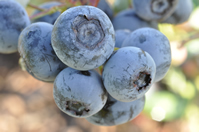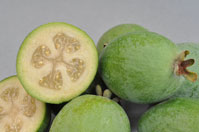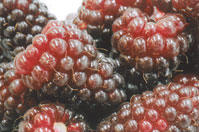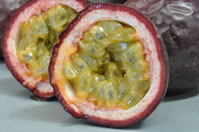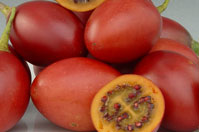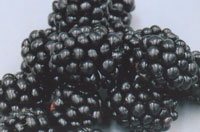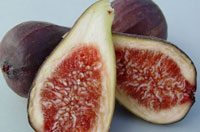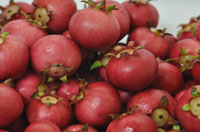
Blackberry & Loganberry |

|
Key Points
- Generally a high-value, reasonably quick return crop in a sheltered situation.
- Only 400-500 winter chilling hours required to maximise yields.
- Late summer into autumn picking season.
- Can produce worthwhile crops for 30 years or more.
- Needs careful management to produce high quality fruit.
Climate
Temperature
A warm, but not baking hot summer, and cool, but not freezing spring is ideal. Cooler temperatures at the onset of autumn promotes the initiation of the flower buds that will produce fruit on second-year wood.
Frost Tolerance
Low-lying, severely frost-prone sites are not suitable as both flowers and fruit are suceptible to a late spring freeze.
Chill Hours
To achieve worthwhile crops blackberries need only 400-500 hours of winter chilling at temperatures below 7°C and therefore can be grown successfully in the warmer Northern areas of N.Z.
NZ climate charts
You can read more about NZ's Cold Hardiness and Climate Zone here
Wind/Shelter
Good shelter is vital as strong winds can damage fruit, foliage and canes but this must be balanced with the need for air movement to reduce the humidity that can promote fungal diseases and fruit rot. Estabishing live shelter belts before planting will help to filter the wind whilst still allowing good air circulation and providing the added bonus of reduced soil moisture loss during dry spells
Sunshine Hours
Most areas of N.Z receive more than adequate sunshine for blackberry production. Excessive heat and glaring sun can reduce yields by stunting growth and scorching ripe fruit however these problems can be alleviated to some extent by judicious irrigation and the provision of live shelterbelts to filter drying winds.
Rainfall
The best scenario for blackberries throughout the growing season would be adequate moisture at the roots with dry foliage, flowers and fruit. They require large amounts of available moisture throughout fruit development and ripening and, if natural rainfall is insufficient to satisfy this need, irrigation is a must.
Soil Requirements
Soil Type
Blackberries produce a vigorous, fiborous root system, almost 75% of which is generally concentrated into the soil's top 45cm. They do best in a well-drained, highly fertile sandy loam with good levels of organic matter to aid moisture retention through dry periods.
Very light and stony soils with poor moisture retention are generally unsuitable for commercial boysenberry production even when there is access to efficient artifical irrigation.Drainage
Good drainage is essential for commercial boysenberry production as they are extremely sensitive to poor soil aeration and consequently suffer badly during prolonged periods of water-logged soil conditions. Heavy, wet clays and low-lying sites that are prone to flooding are generally unsuitable as bramble roots are susceptible to fungal attack and root rots when starved of oxygen.
pH & Soil Testing
An initial soil test should be taken at the earliest possible opportunity to establish the base nutrient and pH levels and to establish if any corrective treatments are required. Blackberries are fairly accomodating to pH readings anywhere between 5.8 - 6.5.
Spacing
The vigorous growth habit of blackberries dictates that they are commonly trained along, and supported by, strong post and wire structures. Plant spacing within the row is usually around 2m to facilitate cane management and fruit harvesting. The distance between rows is dependant on the machinery and management practices used but is usually around 3m.
Crop Establishment
Selecting Varieties
Points to consider include location, climate, the availability of labour and machinery, end-use and your potential markets for the fruit. Be aware also that some varieties attract plant-right royalty fees and/or non-propagation agreements. See our list of varieties for more information.
Planting Time
Autumn/early winter is the preferred planting time but we can supply strong plants in 7cm tubes either in full growth or dormant to suit your needs.
Cultivation
Site preparation should commence up to 12 months prior to planting time to ensure that perennial weeds are eliminated and any drainage issues are resolved. Sub-soiling should be considered to further improve drainage and encourage deeper rooting. Permanent support structures should be erected with planting strips worked to a fine tilth to provide ease of planting and to encourage rapid establishment of young plants.
Fertiliser
Any nutrient deficiencies or necessary pH adjustments indicated by the initial soil test should be corrected by incorporating suitable applications at least 6 months prior to planting. Usually, if this is done, no further fertiliser needs to be added at planting time.
Irrigation
Irrigation may not be necessary in autumn/winter but during dry spells sufficient water should be applied to thoroughly wet and settle the soil immediately after planting.
Tips
Knocking out plants from tubes and packing them into trays will speed planting operations in the field but take care that the roots are protected from the sun and are never allowed to dry out. Plant firmly and make sure that the roots are well covered with soil.
Crop Maintenance
Fertiliser
Nutrients will need to be topped up annually with N-P-K fertiliser applications based on orchard performance, plant appearance and the quantity of fruit harvested. Further soil and/or leaf testing may be required to identify specific nutrient deficiencies.
Irrigation
Maintaining adequate soil moisture levels from flowering, right through to the end of harvest, is essential to maximise yields so regular monitoring is needed to anticipate depletion and to minimise potential plant stress. Good management skills are required to achieve the balance between too little and excessive irrigation as too much water can also create problems .
Where sprinklers are used, they need to be raised above the top of the foliage to allow even distribution. These watering systems have the advantage of being able to be used for frost protection if required. Drip irrigation is suited to blackberry production because it delivers water directly to the roots whilst leaving foliage and fruit dry but, again, careful monitoring is required to ensure that system is working efficiently.Pest & Disease Control
A handful of insect pests can be particularly troublesome to blackberries. Raspberry bud moth can damage canes, flowers and foliage; leafrollers, bronze beetles and leaf hoppers may damage foliage while grass grub larvae prefer the roots and mites can suck the life out of the plants in summer.
Most of the fungal diseases that may affect blackberries manifest themselves where the drainage is inefficent and/or at times of high humidity. Probably the most significant are Botrytis or grey mould that gains access through dead and damaged tissue and can affect all above ground growth (including those precious berries), and 'dryberry' (downy mildew) that can damage the whole plant and may rapidly infect a large percentage of fruit during excessively wet conditions. Good orchard hygiene can do much to minimise the risks but the efficient control of pests and diseases is particularly crucial where markets demand completely blemish-free fruit. Most growers rely on a compehensive agri-chemical spray program for control. Whether or not to apply chemicals is a decision for the individual grower to make but here at Tharfield we use an IPM Services (2009) Ltd integrated pest management program that requires us to regularly monitor our crops, to maintain high standards of nursery hygiene and, where appropriate, to make efficient use of predator insects in order to minimise the need for chemical controls.Weed Control
Troublesome perennial weeds should be eradicated prior to planting. Annual weeds must be carefully controlled to allow the development of the new 'primocanes' that will bear next year's crop. Things change constantly in the world of agri-chemicals so seek advice from your horticultural advisor before applying any herbicides around your crop.
Regular mowing of grass strips or over-all mechanical cultivation can be used to control weeds between the rows.Bird Control
Regular picking can minimise losses but netting protection is required where birds are troublesome.
Pollination
Bees, honey, bumble and wild, are responsible for most of the pollination and, because blackberry pollen cannot be transferred by wind, a large, active bee population is needed throughout the flowering period. This may necessitate the introduction of up to 5 hives per hectare to ensure efficient pollination. As blackberries are self-fertile good fruit set can be expected from a single cultivar planted in isolation.
Harvest & Handling
Picking
High quality berries for the fresh fruit market require careful hand-picking and even berries for processing are usually hand-picked as machinery can severely damage both fruit and plants. Picking is usually carried out on a daily basis, weather permitting, to ensure that the ripeness of the fruit suits the market for which it is intended.
Ideally, picking is completed when the fruit is dry but before the heat of the day affects both the fruit and the pickers.Post Harvest
Blackberries are exremely perishable and fruit must be removed from the field and chilled as soon as possible. It needs to be kept cool and handled with extreme care throughout all grading, packing and transportation operations.
Expected Yield
So many factors can influence yields from commercial blackberry production that it would be misleading to indicate probable yields. See our individual varieties for information about expected fruit set, size and productivity.
More Information
- Temperate and Subtropical Fruit Production, 2nd Edition - Edited by D.I.Jackson and N.E. Looney - CABI Publishing
- IPM Services (2009) Ltd
Enquiry
Please email Andrew Boylan, andrew.boylan@edible.co.nz for quotes or for any other queries you may have regarding our products and services. Minimum orders of 50 units per variety.
So that Andrew can respond to your enquiery promptly, please tell us:
- Your address (so we have some idea of your climate)
- The variety you are interested in
- The approximate numbers required
- Whether you a new grower or an established producer?
Many thanks
